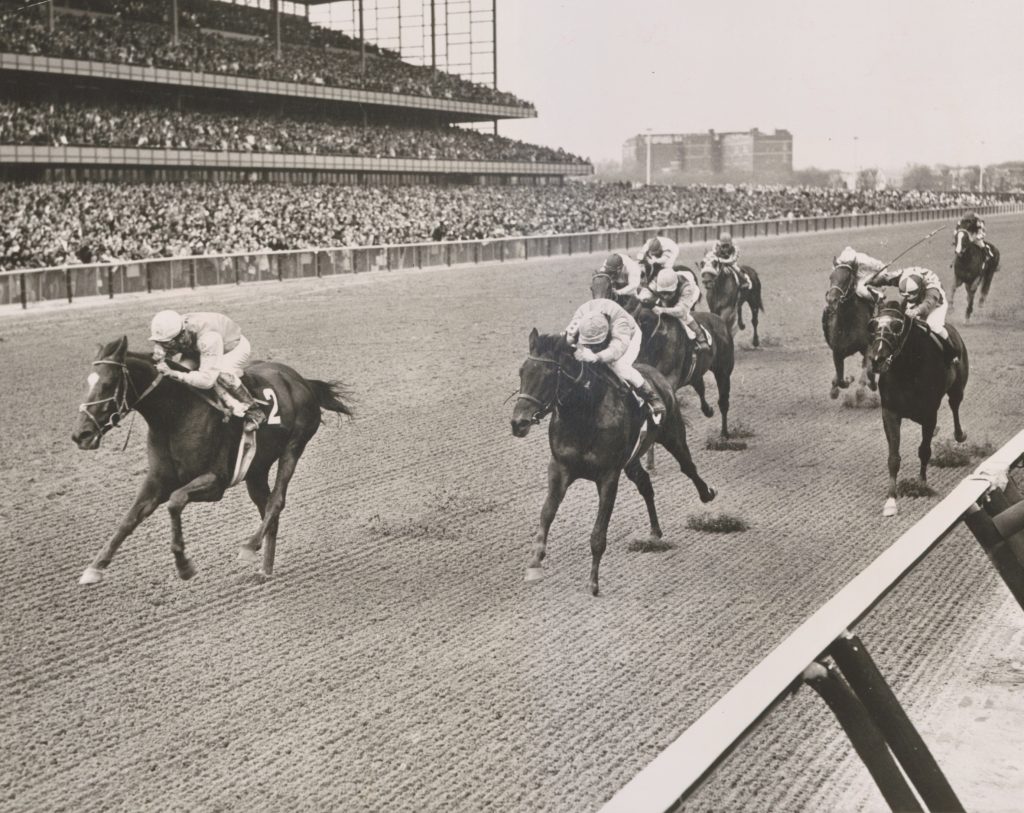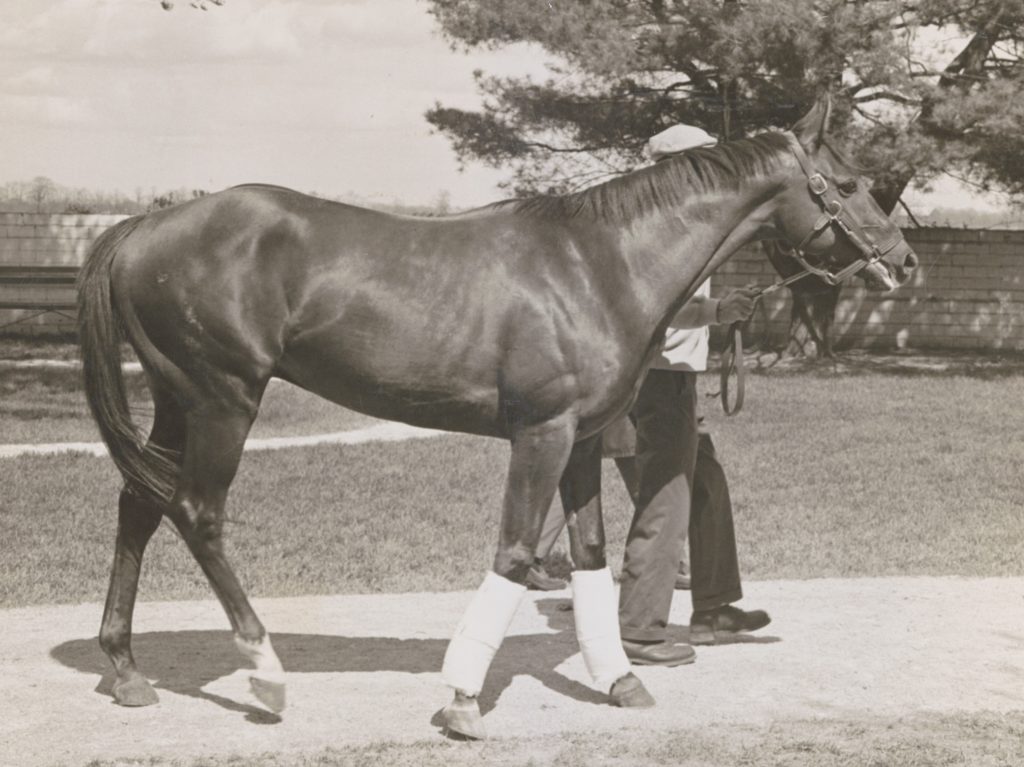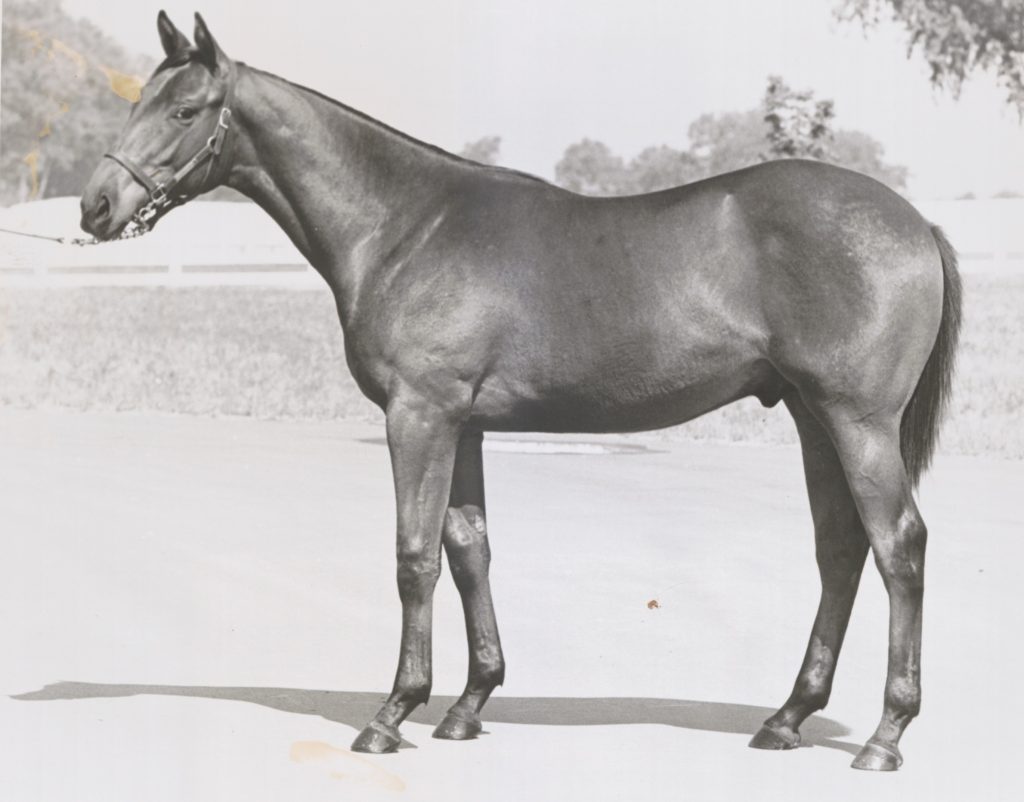
“Photos by Bob Coglianese/NYRA/Thoroughbred Times Collection via the Keeneland Library.”
By Jennifer Kelly
Handsome. Strapping. Beautifully made. A virtual Hollywood leading man in equine form. Majestic Prince was literally a golden boy, a chestnut colt who won regularly and with panache, but found soundness harder to come by. Next to him, Arts and Letters, smaller and not quite as glitzy, churned over a racetrack on legs that were a bit too short for his frame, but with a durability that carried him farther – all the way to Horse of the Year.
In a year when one would vie for history and the other play spoiler, this is the story of two horses who challenged each other in pursuit of glory and gold. Their victories would propel both into an abbreviated rivalry that would leave one question on the minds of those who saw them run: just who was better, Majestic Prince or Arts and Letters?
Deep in Tradition
Truly, it is a challenge to overstate the excellence of Ribot. Bred by the legendary Italian breeding expert Federico Tesio, Ribot went a perfect 16 for 16 in his career, at distances from five to sixteen furlongs, establishing him as one of Europe’s best horses of the 20th century. In 1961, he came to the United States to stand stud on a five-year lease at Darby Dan Farm, where he covered the mare All Beautiful in 1965. In February 1966, All Beautiful, in foal to Ribot, was sold at the William du Pont, Jr. estate auction for $175,000 to Elliott Burch, trainer for Rokeby Stable’s Paul Mellon. On April Fool’s Day, All Beautiful foaled a light chestnut colt with a splotch of white on his forehead. Mellon christened him Arts and Letters.
As a breeder and owner, Paul Mellon was known for his refinement: his interests included fine art, philanthropy, and well-bred Thoroughbreds. In that vein, the aptly named Arts and Letters made his debut at Saratoga, an auspicious location for a debut race, but he didn’t find the winner’s circle until his fourth start at Belmont Park. In his final start for 1968, the colt moved up to stakes company, finishing fourth in the Laurel Futurity.
Four weeks after Arts and Letters’s last race, Majestic Prince made his debut at Bay Meadows in San Francisco. Purchased as a yearling by Canadian oilman Frank McMahon, the Prince was now in the barn of former jockey turned trainer Johnny Longden. The colt’s late debut was a result of bucked shins, swelling around the cannon bones in a horse’s forelegs that required both time and gradual exercise to alleviate. The advantage of a late start out in the mild winters of California meant that Majestic Prince could keep racing into early 1969 as Longden prepared him for the Triple Crown trail. The Prince won his first race and then his second and kept the winning streak in the weeks leading up to the Kentucky Derby.
Arts and Letters opened his season in Florida, winning the nine-furlong Everglades Stakes before logging three second-place finishes in a row in the Flamingo and the Fountain of Youth Stakes, and then the Florida Derby. Mellon had his son of Ribot pointed toward the Kentucky Derby so they sent him to Keeneland for the Bluegrass Stakes as his final prep for the big dance. He had lost the Flamingo and Florida Derby to Top Knight, who was ranked #2 on the list of Derby hopefuls. Even after finishing second in those Florida prep races, Arts and Letters was #3 on the list. Winning the Bluegrass Stakes by fifteen lengths, though, made it seem like Arts and Letters probably should have usurped Majestic Prince at number one.

Johnny Longden wasn’t worried though: “I saw that race and it was a good one, but it doesn’t scare me any.” Majestic Prince remained the top dog in the Derby field, but Arts and Letters couldn’t be ignored. The Prince might have had a Triple Crown winning jockey as his trainer, but Arts and Letters had another legend on his back: Willie Shoemaker. And the Bluegrass gave the Shoe more insight into what the son of Ribot needed to perform at his best. Arts and Letters did not want to be rated, but preferred to run closer to the lead when the pace was slow.
In the Derby, though, the pace might be anything other than slow, especially if Majestic Price had a say in it
Two Times the Bridesmaid
Bill Hartack had been here before. He and Churchill Downs were old friends, as Hartack and found success in the Kentucky Derby four times already. Majestic Prince was his ninth mount in America’s greatest race, one of four horses considered to have the goods to win the roses. If he succeeded, the Prince would be his fifth Derby victory, tying him with the legendary Eddie Arcaro.
Willie Shoemaker was supposed to be here again, joining Hartack in the jock’s room at the Downs for another go at the roses. He was supposed to ride Arts and Letters, whose fifteen-length Blue Grass victory showed that the colt was starting to put it all together. Mellon’s colt had taken his time getting here, but the son of Ribot was on the precipice of realizing that potential that had brought trainer Elliott Burch to point him here. However, they would do that without Shoemaker: before a race at Hollywood Park on April 30th, Shoemaker was mounting the filly Poona’s Day when she spooked and then reared backward. Shoemaker fell off and then found himself under the frightened filly. His injuries included a fractured pelvis and ruptured bladder. He would be out of commission for months. Braulio Baeza got the mount on Arts and Letters and would ride him in all but one of his subsequent starts.
Eight horses went to the post for the 1969 Kentucky Derby, with Majestic Prince on the outside, Dike next to him, and Arts and Letters in the third post. The doors had scarcely closed on the Prince’s stall when the starter hit the button, releasing the field. Ocean Roar sailed out to an early lead, with Arts and Letters settled him behind him and then Majestic Prince in fourth. In the backstretch, Top Knight made a run at the front and took a one-length lead, but faded as the field entered the final turn. At the mile post, Baeza put Arts and Letters on the lead, but Hartack was looming with Majestic Prince, taking the lead as they entered the stretch with Dike on his heels. The Prince grounded out a half-length lead, but Arts and Letters rallied to challenge again as Dike caught up to them both. The three hit the wire together, Majestic Prince eking out the win by a neck over Arts and Letters, retaining his undefeated status.
Two weeks later, the Preakness was much of the same. The Derby winner and the runner-up were in adjacent stalls in Pimlico’s starting gate and, at the start, the two came together, brushing up against each other as they jostled for position into the first turn. Entering that bend, Majestic Prince, who was on Arts and Letters’s left, and Al Hattab, on his right, shifted positions, essential shutting Arts and Letters off. Baeza had to check his colt, likely costing him momentum. Majestic Prince hung off the leaders until the final turn while Arts and Letters ran in sixth. As they rounded into the final turn, Baeza gave Arts and Letters the cue to move, bearing down on the front-running Majestic Prince. And then they hit the stretch.
Majestic Prince held the lead by a length over Arts and Letters. Momentum moved the son of Ribot closer, but the Prince was not having it: he would not let Arts and Letters pass him. As Mellon’s colt moved up inch by inch, the Prince reached down and found the resolve, the gumption to stay in front of his rival. At the wire, the only daylight between these two was Majestic Prince’s refined head.
As Hartack and the Prince jogged back victorious, Baeza dismounted from Arts and Letters and claimed foul against the victor. He alleged that the squeeze from Majestic Prince and Al Hattab entering that first turn compromised Arts and Letters enough to merit a disqualification. The stewards took twenty-five minutes to review the film and decide. In the end, Majestic Prince’s perfect record stayed intact and Arts and Letters came away with another second-place finish. Looking back years after that 1969 Preakness, Baeza said, “I should’ve won that Preakness. Majestic Prince fouled me twice. It took the stewards a very long time to decide. They never take horses down in the Preakness.”
Third Time’s a Charm
With three weeks between the Preakness and Belmont, Arts and Letters’s trainer Elliott Burch elected to send his colt in the Metropolitan Handicap. The trainer had been here before: he had sent both Sword Dancer and Quadrangle in the same race before their Belmont victories. At a mile, the Met was the perfect springboard for Arts and Letters, who was progressing nicely through this late spring racing season. He had worked 1:11 for six furlongs at Pimlico, one of the fastest times at that distance during the whole meet. He was also getting closer and closer to beating Majestic Prince with each meeting between the two, who now stood head and shoulders above the rest of their division. Arts and Letters won the Metropolitan Handicap over a field of ten older horses in 1:34, only two-fifths of a second off the track record. Just nine days later, he was set to meet Majestic Prince for the Belmont Stakes.
Meanwhile, on the cusp of a run at the Triple Crown, Johnny Longden stirred up controversy when he suggested that Majestic Prince should forgo the Belmont Stakes for some time off. His colt had lost weight and was starting to show signs of the wear and tear of his undefeated career, suspecting that the colt’s ankles were bothering him. Longden worried that the same ankle issue that had plagued his grandsire Native Dancer and then forced the early end to his sire Raise a Native’s career was now rearing its ugly head as they prepared majestic Prince for the Belmont. Owner Frank McMahon knew that the odds were overwhelmingly against him ever being in this spot again so he overruled Longden and sent his colt to the post for a chance at immortality.
Twenty-one years had elapsed since Citation had become the eighth Triple Crown winner. Five other horses had won the Kentucky Derby and the Preakness Stakes and then taken their bets shot at the Belmont only to fall short of the elusive third jewel. Did Majestic Prince have enough left in his tank to finish the job or would some other horse thwart his shot at glory? Did Arts and Letters have what it takes to play spoiler?
The field of six broke cleanly from the starting gate, but no one wanted to take the clear lead for the marathon mile and a half. Dike, who had finished third behind Majestic Prince and Arts and Letters in the Derby, reluctantly became the front runner and stayed there until Arts and Letters decided he had had enough. All on his own, without any prompting from jockey Braulio Baeza, Paul Mellon’s son of Ribot grabbed the lead from Dike with a half mile to go, his lead a half-length, then three lengths, and finally five and a half lengths at the wire. Behind him, Majestic Prince passed Dike to finish second, never getting closer than a length to Arts and Letters throughout the entire twelve furlongs. The same stretch battle that had marked the Derby and the Preakness never developed. Arts and Letters had finally defeated Majestic Prince and spoiled another Triple Crown in the process. It would be another four years before a horse would finally end the drought.
The Changing of the Guard
With his winning streak broken, Majestic Prince went to the sidelines, a series of ailments keeping him off the track for the rest of 1969. Between those pesky ankles and osselets, calcium deposits on his ankle bones, Longden never could get the Prince sound enough for racing again. Early 1970 saw the four-year-old Majestic Prince retired permanently and sent to stud at Spendthrift Farm. Of the 187 winners and 32 stakes winners he sired, his best was Coastal, who won the 1979 Belmont Stakes and spoiled Spectacular Bid’s try for the 12th Triple Crown.
With Majestic Prince’s exit, Arts and Letters became the star of the three-year-old division. He followed up his Belmont Stakes victory with wins in the Jim Dandy, the Travers, and the Woodward Stakes before finishing out 1969 with a victory in the two-mile Jockey Club Gold Cup. At year’s end, Majestic Prince and his nine wins in ten starts were not enough to beat Arts and Letters’s long list of stakes races won that year. Paul Mellon’s colt was named Champion Three-Year-Old, Co-Champion Handicap Horse, and Horse of the Year.

At four, Mellon had planned to send his champion to France to run in the Grand Prix de Saint-Cloud, but Arts and Letters stumbled at the start of the Californian Stakes and finished sixth after injuring his left foreleg. He was retired to stud at Greentree Stud in Lexington, where he went on to sire horses like Winter’s Tale, Lord Darnley, and the 1980 Preakness Stakes winner Codex.
Just as memorable as his victories on the track might be the friendship with another Belmont Stakes winner he had off the track. At Greentree, his neighbor was 1968 Belmont Stakes winner (and Triple Crown spoiler) Stage Door Johnny. The two stallions would race each other in their paddocks, starting at the top of the hill and then racing down the fence line to the paddock gate. The two were virtually inseparable, so much so that when Greentree was sold to Gainesway Farm, the contract stipulated that the two stallions remain in their adjacent paddocks for the rest of the lives.
Stage Door Johnny passed away in 1996 with Arts and Letters following two years later.
Arts and Letters might not have had the dashing looks of Majestic Prince; he might not have made it into the Hall of Fame before his rival did (1988 vs. 1994). However, the son of Ribot and All Beautiful did have something that the Prince did not: the ability to run all day and the soundness to do just that over and over. Sometimes even the little guy gets his time to shine.




